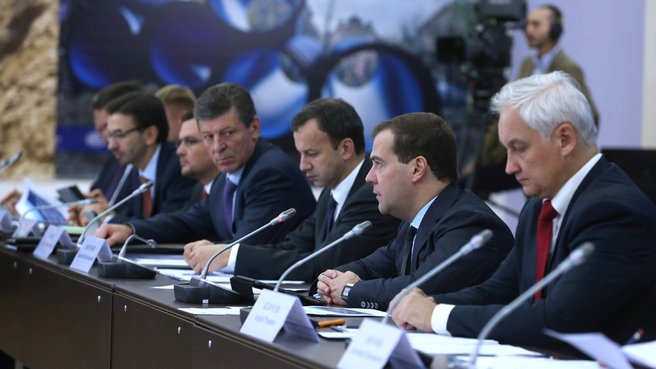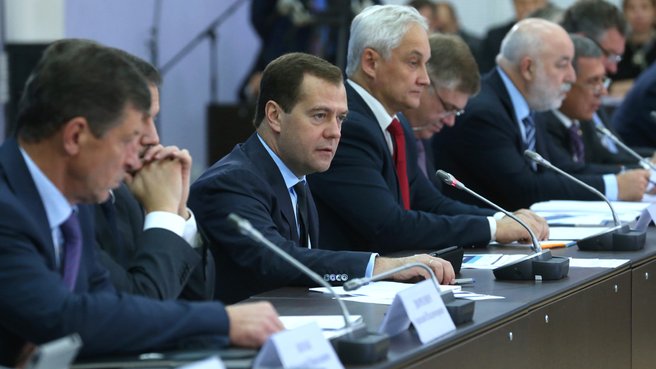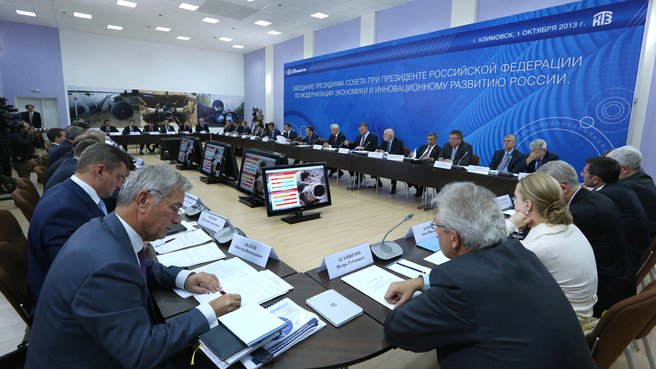The meeting focused on the innovative development of the housing and utilities sector.
Dmitry Medvedev’s opening remarks:
Good afternoon, ladies and gentlemen. At this meeting of the Presidium we’ll talk about the innovative potential of what is probably the most problematic sector in our economy – I’m referring to the housing and utilities. It is ridden with problems that we’ve discussed repeatedly at different levels. I won’t repeat them – you know them all very well.
Let’s focus on the innovative aspect today. There are many opportunities; the market is huge and potentially very promising. We have enormous water and gas resources. However, when they travel through pipes a lot is being lost and this is our biggest headache. Published statistics show that up to 27% of water and no less than 15% of heat is lost during transportation. This is truly unacceptable, which is why we are meeting at this plastic pipe factory.
On average, we use one third or even fifty percent more energy resources for housing and utilities than European countries do. We did the planning decades ago. The utilities infrastructure and technology used during the massive housing construction in the late 1950s and early 1960s were advanced for that time, but now they have become largely obsolete. One of the most pressing issues is the need to adopt new norms. After seeing the equipment displayed at the exhibition we immediately felt the need to update the relevant norms. Modern technological and managerial solutions can save enormous resources. As usual, I’ll issue a number of instructions at the end based on the results of today’s Presidium meeting.
I’d like to make a few points to start the discussion. First, the infrastructure is worn out. The service life of about 60% of our basic assets has been exceeded. This means more accidents and greater losses during transportation, as well as exorbitant operating costs. Funds are spent on maintaining the operating capacity of existing system, while upgrades are financed by whatever is left over. This is probably one of the main challenges we must overcome.
The government is taking part in upgrading the housing and utilities sector via federal targeted programmes and the Housing and Utilities Reform Fund. But although we all understand that there is never enough money, we should still try to make the most of it by investing in the most modern technology and the longest-lasting and most energy-efficient materials. Renovated facilities must also be monitored. They should be equipped with automated diagnostic systems and meters. This is already being done in many cases.
Second, regrettably this sector does not appeal to investors. It seems like it should have investment appeal because it is huge and will have to operate regardless of any crises or other developments in the world markets. It should be attractive but it isn’t yet.
To increase the share of private investment in the housing and utilities sector we must complete the regulatory framework for relations in this sphere. The regions should take a more active part in these efforts, all the more so since they are supposed to approve water- and heat-supply patterns, perform inventories of housing and utilities facilities and adopt long-term decisions on prices in the near future.
Speaking about the rates charged by the natural or infrastructure monopolies, we have made many difficult decisions to ensure that they do not go up for industrial customers. Rates for the population will be based on the inflation minus 30% formula. Hopefully, this will help lower rates and make life somewhat easier for our citizens. In this context, special attention should be paid to the introduction of innovations, as this is the key to reducing costs.
Third, there is the issue of technical regulation. A system of norms, standards and rules requires regular upgrades and we must encourage the use of new materials and technology. At the same time, we must toughen requirements on the relevant equipment and the safety and reliability of infrastructure as a whole.
Fourth, the government is promoting innovations through development institutes. From 2011 to 2013, it has invested about 53 billion roubles in housing and utilities projects, including more than two billion for direct support of R&D and cooperation programmes between universities and high-tech industry.
And there is one more subject I’d like to mention (we discussed it while walking around the plant). I’m referring to the demand for domestic materials and equipment. This plant is using domestic materials, which is a good thing, but needless to say, all the equipment is foreign-made because we don’t produce it ourselves. Meanwhile, Russian industry can offer many types of competitive products. This applies to the pipes we’ve seen today. However, Russian goods are rarely the preferred choice. We must create conditions to make it more profitable not to import equipment but to borrow the best technology and localise production in Russia. This has already been done to a degree but not on an adequate scale.
These are the issues I’d like to draw your attention to today.
<…>











